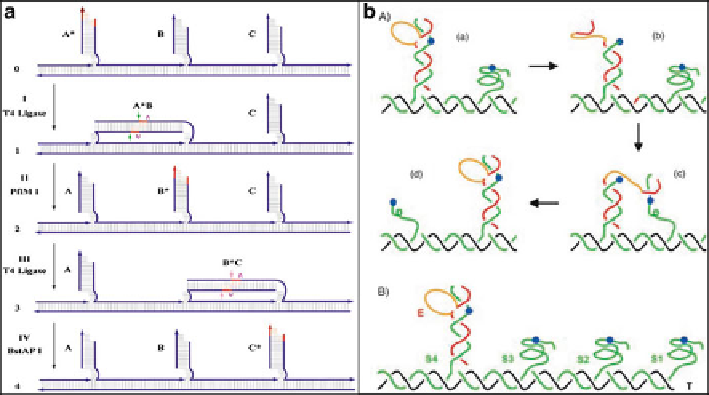Biomedical Engineering Reference
In-Depth Information
Fig. 12.2
(
a
) A DNA walker driven by enzymes (Reproduced from Ref. [
16
] by permission of
John Wiley & Sons Ltd.). (
b
) Pierce's processive bipedal DNA nanomotor (Reproduced from Ref.
[
17
] by permission of John Wiley & Sons Ltd.)
control of the biped walking forward or backward. A month later, another walker
made by Pierce and coworkers came out [
15
], the idea of which was from motor
proteins' intracellular transporting in biological systems. It was a processive bipedal
DNA nanomotor that moved by advancing the trailing foot to the lead at each
step, and real-time monitoring of walker movement was achieved via multiplexed
fluorescence quenching (Fig.
12.1
b). In their design, two kinds of strands played
a key role in DNA walkers' moving, which was called “set” and “unset” strands.
Usually, the “set” strands could anchor the walker to one stand on the track with
several bases overhang, or “toehold,” which were not complementary to any strands
of the walker or the track, while the “unset” strands firstly hybridized with the
toeholds and then fully hybridized with the “set” strands to make the walker leave
the stand. After another “set” strands coming in, the walker was anchored to another
stand on the track so that the walker's moving came true.
Different from the walkers mentioned above, an autonomous DNA motor using
enzymes and powered by hydrolysis of adenosine triphosphate (ATP) had been
reported [
16
]. In this system, the DNA fragment could be continuously translocated
along one direction by the combination of a DNA ligase and two restriction endonu-
cleases (Fig.
12.2
a). Can DNA walkers move without any human interference or
other external active components such as protein enzymes? Mao et al. demonstrated
that such a machine is feasible [
17
]. In their design, the walker contained a 10-
23 DNAzyme, which was a DNA molecule and could cleave RNA with sequence
specificity. Under the cleavage by DNAzyme and DNA branch migration, the walker
could move on the track. Although this walker could move autonomously without
any interference, its shortcoming was the walker could not move backward but go
straight along the track.

Search WWH ::

Custom Search